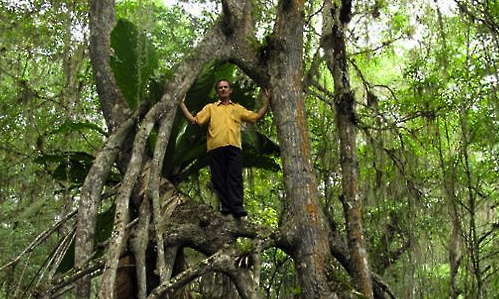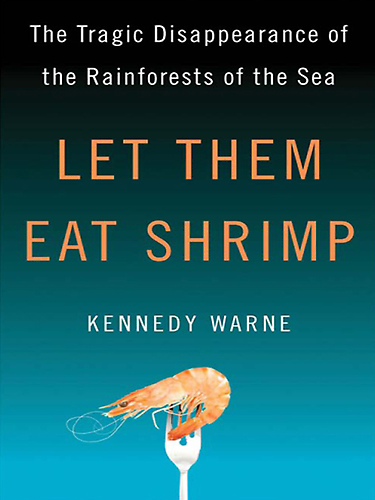 Kennedy Warne in a mangrove tree.For his new book Let Them Eat Shrimp: The Tragic Disappearance of the Rainforests of the Sea, Kennedy Warne traveled the world — from Bangladesh to Brazil to the Gulf Coast — documenting the complex relationship between the growing shrimp farming industry and the world’s mangroves. (Up to 70 percent of the these aquatic forests have disappeared in the last 40 years.) The former editor of New Zealand Geographic spoke to Grist recently about what he found.
Kennedy Warne in a mangrove tree.For his new book Let Them Eat Shrimp: The Tragic Disappearance of the Rainforests of the Sea, Kennedy Warne traveled the world — from Bangladesh to Brazil to the Gulf Coast — documenting the complex relationship between the growing shrimp farming industry and the world’s mangroves. (Up to 70 percent of the these aquatic forests have disappeared in the last 40 years.) The former editor of New Zealand Geographic spoke to Grist recently about what he found.
Q. Can you start by describing the relationship between mangroves and shrimp?
A. Mangrove forests are nurseries for a vast array of marine species, including many species of shrimp. However, this nurturing relationship between a protective habitat and vulnerable sea creatures has been sundered in the past half century as mangroves around the world have been destroyed to create ponds for aquaculture. And guess what’s being grown in those ponds? Shrimp. Think about it: The natural nurseries for wild shrimp have been eliminated to create space for the production of farmed shrimp. A bitter irony, is it not?
Q. Outside of the Deep South, mangroves are not so common in the U.S. Can you give our audience a primer on these “rainforests of the sea?”
A. I call mangroves “ecological Swiss army knives” because they have so many ecosystem benefits. I already touched on one: nurseries for marine life. In Florida alone, more than half the species of commercially caught seafood start their lives in mangrove forests, amongst their labyrinths of interweaving trunks and roots that enable them to hide from predators. That same labyrinth acts as a natural buffer against storm surges, making mangroves the coastal shields of tropical coastlines.
Not only do the mangrove palisades quell the power of incoming waves, they trap sediment washing off the land, slowing erosion and actually building new areas of dry land. Acre for acre, mangroves are among the most biologically productive ecosystems on Earth, and also among the very best at storing carbon — a hugely important service in mitigating climate change. They also provide food and habitat for species ranging from mudskippers to macaques, beetles to kangaroos, and vipers to tigers.
Q. Why do you believe shrimp farming has taken off the way it has in places like Asia and South America?
A. Shrimp is a tasty and desirable seafood. By farming it in the developing world, where land and labor are cheap, it can be imported to developed countries at a price that makes it affordable to the majority of people. That’s why shrimp has displaced tuna as the No. 1 seafood consumed in the United States. For the countries where it is farmed, the west’s consumption of shrimp is a rich source of foreign exchange. So with shrimp two types of hunger are involved: the hunger of western palates for a luxury seafood at an affordable price, and the hunger of developing countries for export earnings. The fact that these two hungers drive the people who traditionally rely on mangroves to literal, physical hunger (through being displaced from mangrove lands) doesn’t figure in the equation.
 Q. Fish farming is often seen as a way to protect wild seafood. Can you explain why — in the case of shrimp farming — that is rarely the case?
Q. Fish farming is often seen as a way to protect wild seafood. Can you explain why — in the case of shrimp farming — that is rarely the case?
A. First of all, because shrimp are carnivores. They don’t grow fat on sunshine. They have to be fed, and the most common food source is fish meal. It can take up to three pounds of fish protein to produce one pound of shrimp protein — that’s the conversion ratio. Where does the fish meal come from? From the sea. Far from taking the pressure off the world’s diminishing fish stocks, shrimp farming adds to the problem. Second — a point which I mentioned earlier — is that by removing mangroves you remove natural fish nurseries, reducing the ability of wild fish stocks to replenish themselves.
Q. You talk about the way that shrimp farms in the developing world are sold as job-creators, but illustrate that, in fact, rice paddies can employ more people on the same-sized plot of land. Can you compare these two types of farms generally?
A. What I saw over and over again was that local people derive very little benefit from shrimp. They certainly can’t afford to eat it. And the few jobs that are created by the industry (which is not labor intensive) are often not pleasant, involving the handling of toxic chemicals. It was in Bangladesh that I learned about the relative rates of employment on land planted in rice and land converted to shrimp ponds. [A line in Let Them Eat Shrimp reads: “A shopkeeper in Burigoalini told us that a rice paddy supports 100 people while an equal-sized shrimp farm supports five.”] There is antagonism between the practitioners of agriculture and aquaculture on this point. There isn’t enough land to go round, and it is subsistence laborers who lose out.
Q. You describe the time you spent with the estimated 500,000 people who catch wild shrimp fry for a living in Bangladesh; that’s a population I was totally unaware of. Can you say more about them?
A. Although the majority of larval shrimp fry used in shrimp aquaculture is produced in hatcheries, in Bangladesh many shrimp farmers prefer wild-caught fry, believing that they are more robust and resistant to disease. This preference has allowed a huge fry fishery to develop. I saw waterways on the outskirts of the Sundarbans, in southern Bangladesh, that had armadas of fishing boats anchored across them, each one with a billowing net made of mosquito netting streaming out in the current. The collateral damage on other species is immense. It has been estimated that 99 percent of what the fishers catch is non-target finfish and shellfish larvae, all of which is discarded. The Bangladesh government recognizes that this colossal wastage is an environmental disaster, and has outlawed the shrimp fry fishery, but the law is unpopular and not enforced — not least because many people have no other means to make a living.
Q. What do you think of recent efforts to “green the blue revolution” by using less wild seafood, organic feed, etc.? Will these efforts make a real dent in the ecological damage being done?
A. The shrimp industry says repeatedly that the old slash-and-bulldoze era is over. “Sustainability” and “certification” are the new watchwords, it says. But people I’ve met in Ecuador and northeast Brazil tell me that shrimp farm expansion is still happening, and mangroves are still being affected. Even if a shrimp farming operation is no longer cutting down trees, the process of creating ponds near the shoreline can destroy mangroves by altering the local hydrology. I applaud the industry’s efforts to bring greater sustainability and accountability to its practices, but that shrimp farming occurs in some of the least populated, most remote coastlines on the planet. It is hard to bring effective monitoring and regulation to such areas, which are the ecological “wild west.”
Q. What was most memorable about the movement of working people you encountered which had sprung up in recent years to protest — and in some cases block — the development of shrimp farms in Latin America and beyond?
A. First and foremost, bravery. It is not easy to stand up to powerful industrial concerns. I heard many stories of beatings and shootings of people who protested, trespassed, or otherwise resisted shrimp expansion. In the book I report a conversation I had in Quito, Ecuador, with a man who was described to me as a “stone in the shoe” of shrimp farmers. This man was in hiding for his and his family’s safety, having received death threats for his anti-shrimp campaigning. Second, I was impressed and moved by the creativity, commitment, and solidarity of los pueblos del manglares, the people of the mangroves, who have used all sorts of ways, from poetry and painting to film-making and ecotourism, to get the message to the wider population that mangroves are their home.
Q. What can Americans do to address the problems you raise in Let Them Eat Shrimp?
A. Public awareness and consumer pressure are two key ways to secure a future for mangroves and the people who rely on them. Mangroves don’t have the charisma of forests like the Amazon. Rock stars and celebrities don’t line up to lend their names to “save the mangrove” initiatives.
I think consumers need to look long and hard at their consumption of farmed shrimp. (And two-thirds of the shrimp consumed in the U.S. is imported farmed product.) Consumers should be asking their suppliers where the shrimp they’re selling comes from, and trying to determine not just if it is sustainably farmed, but also what are the social impacts of that farming.
When I was in the U.S. on a book tour recently, I was told that social justice was not a motivating factor for American consumers. That unless I could identify some kind of health problem with eating farmed shrimp, changing consumer behavior was unlikely to happen. But I think change is happening. More and more people are making connections between the food on their plates and the people and pathways involved in producing it. We have the opportunity to make informed, enlightened, ethical choices. For the good of the planet and some of its least visible citizens, we should exercise those choices.

